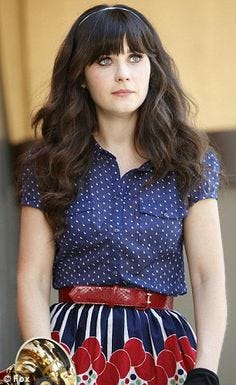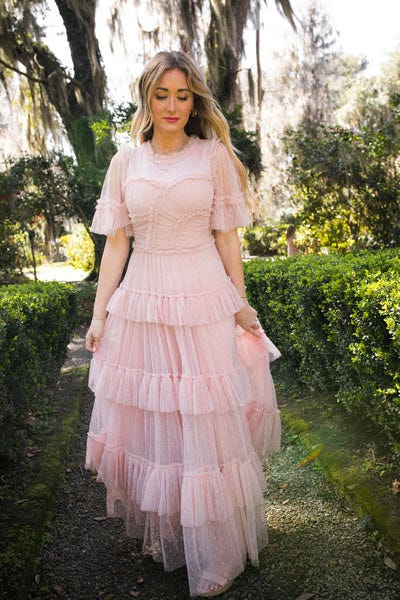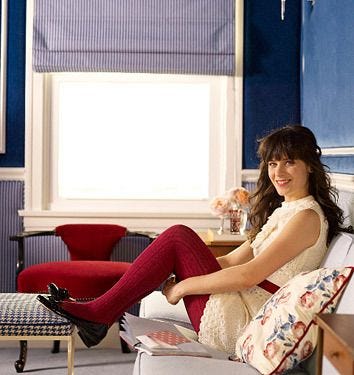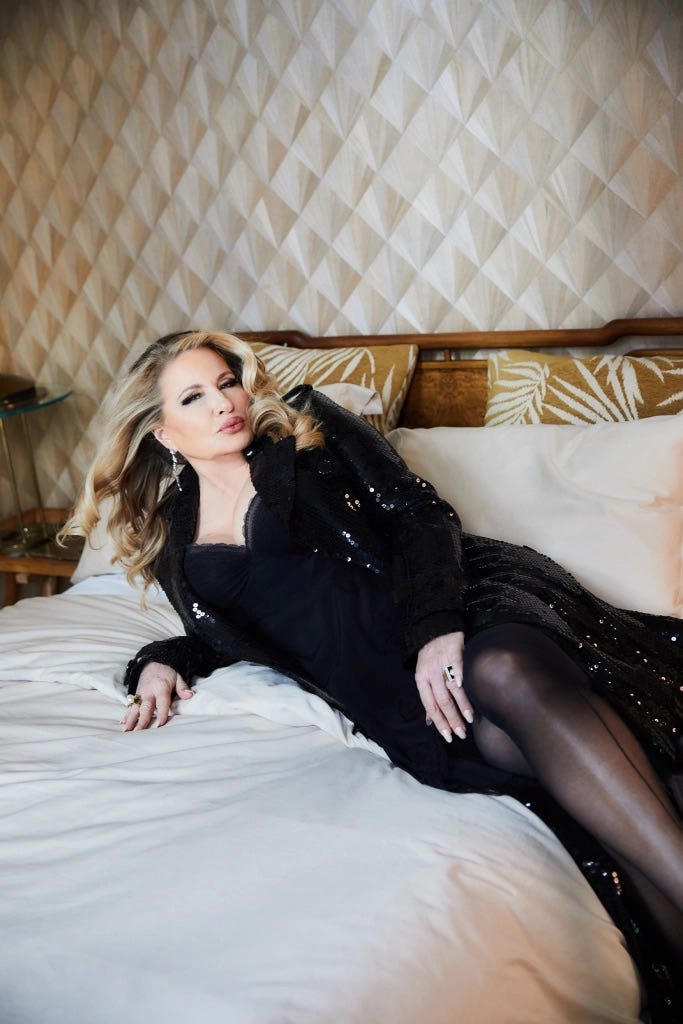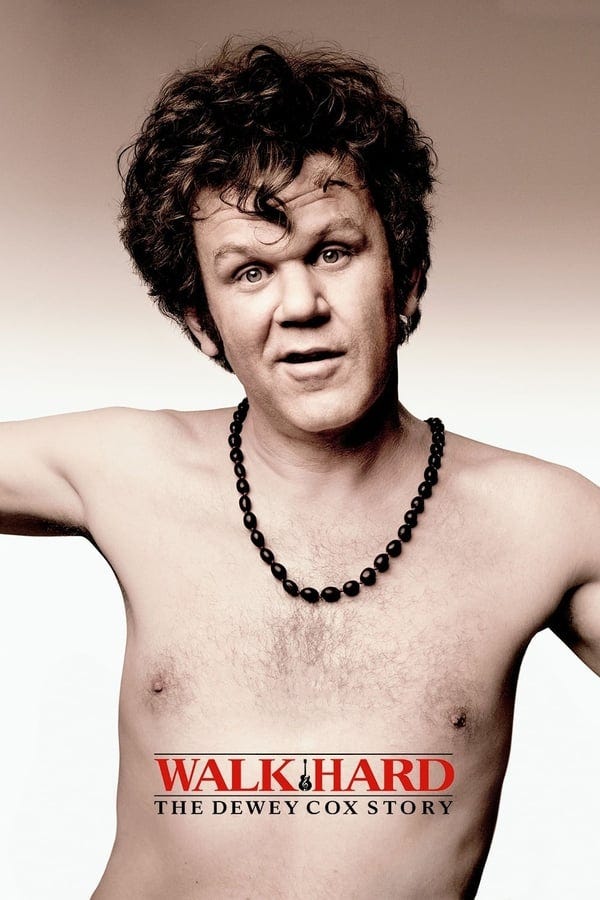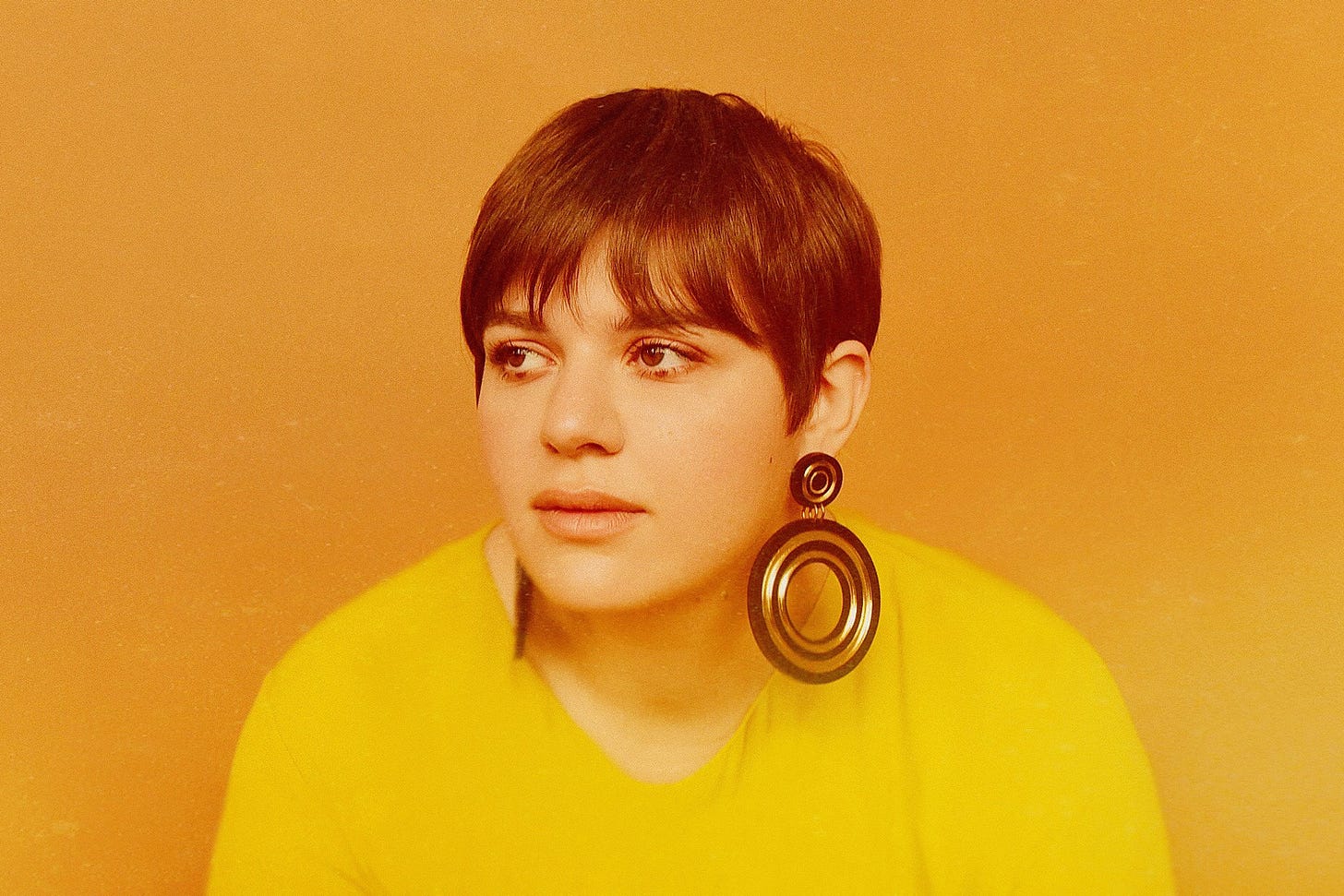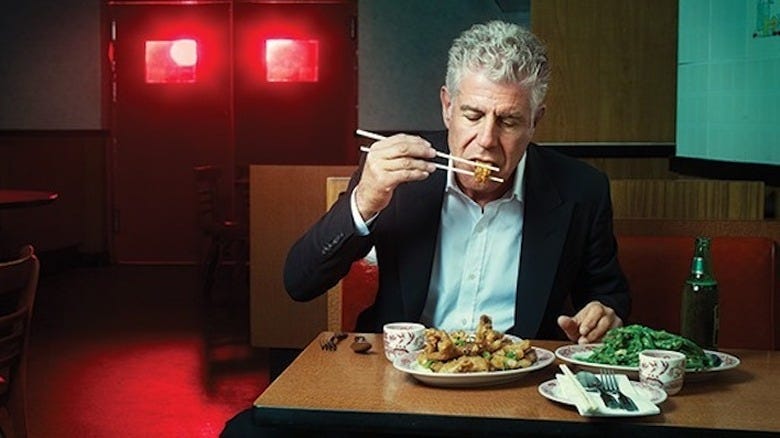"Universally Flattering" is a Lie
Plus, a cautious case for gin, revisiting Dewey Cox, and rooting for Yebba
I love the show “New Girl.” In our house, it’s one of those old familiar standbys – comfort viewing for the Elder Millennials. But today’s hot take isn’t about the show, but rather what High Priestess of Quirk Zooey Deschanel wore on the show. Actually, what Zooey wore on the show as Jess Day is not much of a departure from what she wears in real life, or in “500 Days of Summer,” or when she’s plucking the ukulele to the Great American Songbook.
The look is a mashup of midcentury housewife and merch girl at a Belle and Sebastian concert – that is to say, wardrobe bursting with whimsical prints, puffy sleeves, and teacup silhouettes routinely lauded as universally flattering to the female form.
But is anything truly universally flattering?
Most women of a certain age carry the scars of shopping for clothes as a teenager, when you first decided to curate a wardrobe modeled after the starlet du jour, only to find yourself crying in a dressing room because the look didn’t translate. The mental surround sound told you that it was your body that was wrong, not the clothes. As a girl growing up in the conservative south, it was this particular “universally flattering” aesthetic that was thrust upon me over and over again. Soft, flirty, flouncy, and coy. It was big in the 50s, big in the Deep South, and bigger even now as the tradwife phenomenon gains traction in response to the ever-divisive American gender debate.
My personal dressing room verdict? Soft, flirty, flouncy, and coy: nice in theory, terrible in practice.
“Universally flattering” femininity:
Me in the same dress:
Turns out, when you’re a silver-tongued she-devil stacked like a brick house, soft, flirty, flouncy, and coy will make you look like you’re cosplaying a woman - like Will Ferrell in a Bo-Peep costume. Similarly, when Zooey Deschanel wears nylons and a little dress, she looks like a gamine elementary music teacher. If I wear that same exact outfit, I look like a homewrecker in a Lifetime movie.
What I think I’m serving:
What I’m actually serving:
Off-putting or appealing, depending on your taste, but either way, it flies in the face of the “universal” theory.
Turns out, when you’re a silver-tongued she-devil stacked like a brick house, soft, flirty, flouncy, and coy will make you look like you’re cosplaying a woman - like Will Ferrell in a Bo-Peep costume.
Any young woman who has been terrorized by a school or office dress code can attest to this phenomenon. Take something as seemingly innocuous as a turtleneck and then put it on both a doe-eyed waif and someone who is bold, tall, and curvy, and guess who is getting the side-eye? The always unnecessary “who wore it better” tabloid feature is another example of this. Personal style is never an apples-to-apples scenario. How clothes sit on one celebrity won’t translate the same way on the next, and it’s not because one body is superior the other, it’s because good style is at the intersection of one’s unique personality and proportions, creating a veritable kaleidoscope of fashion outcomes.
A lot of the time, physical proportions beget personality, and personality begets style. Jennifer Coolidge and her luscious curvature make it nearly impossible for her to be a shrinking violet. In her recent re-emergence as America’s favorite vampy comedienne, she’s also served as a muse to designer Christian Siriano, who has created endless dramatic looks for her, suitable not just for her tall, full figure, but for her specific brand of firecracker glamour.
Designers like Siriano, who has also dressed Ashley Graham, Lizzo, Oprah, Whoopi, Billy Porter, and Lavern Cox (among many, many others), are investing in a new class of unexpected tastemakers and are making an impact on fashion’s future trajectory. Same goes for risk-taking social media influencers like Gabi Gregg, Blake Gifford, Kelly Augustine, and Kate Sturino, who have skirted traditional gatekeepers and capitalized on their digital reach to democratize fashion in ways that would have been unimaginable 10 – 15 years ago.
And this is not just about style for style’s sake. Not to get all Miranda Priestly on you, but parameters of what is flattering can greatly impact the ethos of any given era. The notion of flattering is a lens through which people view educational and professional mobility, identify a mate, and stockpile social capital. Style shapes perception, and perception unlocks opportunity. Since opportunity springs from culture – because culture creates demand – we can better understand how our ever-evolving standards of beauty are inextricably linked to, well, nearly every facet of our lives. Move over, Stephen Hawking. This is the new Theory of Everything.
Style shapes perception, and perception unlocks opportunity. Since opportunity springs from culture – because culture creates demand – we can better understand how our ever-evolving standards of beauty are inextricably linked to nearly every facet of our lives.
On a systemic level, Big Fashion’s continued investment in styling and amplifying diverse bodies and tastes – and one might argue if that investment is really happening – can have a positive trickledown effect on the masses, shifting cultural norms, breaking down barriers to opportunity, and expanding what is still a very narrow Eurocentric definition of beauty. Most of us don’t have that level of institutional power, though, so as individuals, it would behoove us to extract ourselves from this antiquated “rules of style” brouhaha in the meantime. Stop buying into it, stop imposing it on our children.
Because when it comes to the concept of what’s flattering, there is no universality, only seasons. Beauty conventions are cyclical. Sometimes what you’re bringing to the potluck is hot, sometimes it’s not. One moment you can only aspire to the unattainable, the next you are the unattainable. In the immortal words of Lady Gaga, “One second I’m a Koons fan, suddenly the Koons is me.”
And at the end of the day, you’re not Zooey Deschanel or Jennifer Coolidge, you’re you. And while we’re all about bucking conventional wisdom around here, one fashion adage remains true: You wear the dress, the dress doesn’t wear you.
Gin is kind of like the pit bull of liquor. Rich but complicated history, unfairly maligned, and capable of ripping your face off if not handled with care. Since I like to dally with danger, gin and soda is probably my most ordered drink. And I do mean soda, not that tonic garbage. I want to really taste the juniper potpourri as it poisons my veins.
And I’m not alone – gin is making a comeback. Though it’s been slow and steady over the last 20 years, my own anecdotal observation is that gin is popping up more and more on the “signature cocktails” section of restaurant menus, signaling a mainstream appeal that it didn’t have when I first started drinking 20 years ago and had countless cautionary tales about its homicidal effects thrust upon me by my elders.
Not convinced? Try this classic “equal parts” cocktail, The Last Word, before totally boxing gin out of your happy hour repertoire. Equal parts cocktails are exactly what the name implies – all ingredients are measured the same, making them quick and easy. (The Negroni is another popular equal parts drink.)
¾ oz Gin (Hendricks is my favorite)
¾ oz Lime
¾ oz Luxardo Maraschino
¾ oz Green Chartreuse
Cherry garnish
Add to the shaker with ice, strain, pour into a chilled coup glass, and drop in the cherry for good measure.
Drunk history: It was named after me because I always have to have the last word.
Share your cocktails with me on Instagram! @theokaypokay #okaypokaypours
In 2004, the Ray Charles biopic starring Jamie Foxx was released, raking in $125 million at the box office worldwide. Within a year, Hollywood gave Johnny Cash the similar treatment with “Walk the Line,” which brought in over $186 million globally.
Then, two years after that, there was “Walk Hard: The Dewey Cox Story.” It brought in $20 million against a $35 million budget, was labeled a box office bomb, and to this day, half the people I quote it to have no idea what I’m talking about. If you’re one of those people, you need to go watch it right now, because “Walk Hard” is one of the finest examples of Hollywood parody ever produced.
John C. Reilly’s portrayal of the fictious Dewey Cox encompasses biographies of Roy Orbison, Glen Campbell, Bob Dylan, Jerry Lee Lewis, Donovan, John Lennon, James Brown, Jim Morrison, Conway Twitty, Neil Diamond, Hank Williams, and Brian Wilson. There are tongue-in-cheek portrayals of Buddy Holly, Elvis, and the Beatles, as well as tributes to the stylings of David Bowie, Billy Joel, and seventies punk rock, among other source material. Not since “Spinal Tap,” has a film so effectively skewered (and adored) rock n’ roll.
Favorite moments not to miss:
You don’t want no part of this shit – Recurring bit in which Tim Meadow’s drug dealing drummer character waxes poetic about drugs in a half-baked (pun intended) attempt at dissuading Dewey from partaking.
That was freakin’ transcendental, Paul McCartney – Dewey finds himself at an Indian meditation retreat at the height of The Beatles’ Yellow Submarine era, with Jack Black portraying Paul McCartney, Paul Rudd as John Lennon, Jason Schwartzman as Ringo Starr, and Justin Long playing George Harrison.
I want an army of digeridoos. Fifty thousand digeridoos! – While on a drug bender, Dewey records “Black Sheep,” an over-the-top homage to the Beach Boys’ “Pet Sounds” that includes the painful screams of his wife in labor in the control booth.
In my dreams you’re blowing me…some kisses – A pitch perfect parody of the June and Johnny Cash duet played by Joaquin Phoenix and Renee Witherspoon in “Walk the Line.”
Let me know when you’ve watched it so we can say things like “You can take the children, but you leave me my monkey” to each other.
In 2016, Yebba performed her original song, “My Mind” at a NYC Sofar Sounds session. Ed Sheeran would later say that the performance, which occurred just one week before Yebba’s mother died from suicide and would be a catalyst for her mental health advocacy, was so powerful that it made him cry.
He went on to sign her to his record label and since then, she has had a prolific career as a collaborator with artists like PJ Morton, Sam Smith, Mark Ronson, Stormzy, Ed Sheeran, A$AP Rocky, and Drake, and ultimately signing with RCA and then releasing her full-length album, Dawn, in 2021.
The first time I ever heard Yebba was when she was performing background vocals for Chance the Rapper’s SNL performance in 2016. The second time was her single, “Distance.” I was absolutely blown away by her effortless vocal range and the song’s jazz fusion sound, which somehow sounds decades old while also being completely modern.
I finally had the opportunity to see her live as the opening act for John Mayer’s Chicago last year, but the crowd nor the sound system did her justice. She is an act deserving of her own stadium tour, but probably best experienced in a space as intimate as her songwriting.
LISTEN: Distance | NPR Tiny Desk Version
Dear Rachel,
I don’t know what to make for dinner tomorrow. It’s part of my bigger issue of never feeling like there are enough hours in the day, and that meal planning is a constant chore that I can never keep up with. Any suggestions?
Tired in Toledo
Dear Tired in Toledo,
At first, I wasn’t going to attempt to answer your question because I’m not the cook in my house. My culinary skills are limited to the art of assembly – in other words, finding 100 different aesthetic ways to orient a soft-boiled egg on a piece of toast and calling it lunch. But two things I do know how to do are shop and be hungry, which, while not technically making dinner, are still critical steps on the path to the right meal solution when you’re in a slump.
My recommendation is two-pronged: operational and inspirational. On the operational side, it’s about turning the mundane act of selecting and shopping for a meal an experience. My husband and I have compiled quite the little collection of glossy cookbooks with beautiful, yet reliable, recipes that make dinner feel special. Our favorites include Half Baked Harvest, Mediterranean Every Day, and Barefoot Contessa at Home.
Speaking of Barefoot Contessa, she recommends getting all your ingredients from mongers. Cheese mongers, fish mongers – she knows so many mongers! But if you are a filthy little peasant who doesn’t know any mongers, you’ll have to go to the grocery store.
Yes, it can be drudgery, but you can minimize the slog of humanity by popping on the headphones as you select your cart and blast your hype genre of choice. I personally like to listen to the Women of Hip-Hop playlist on Spotify. It’s such a satisfying experience to be listening to Foxy Brown while I wait in line at the Whole Foods dairy fridge. It’s EDGY. Look at Rand and Nance with their cottage cheese. I mean, I’m white but I’m not that white.
But sometimes it’s not even a matter of operations, it’s about inspiration. Maybe you don’t want to cook and the ol’ ball and chain suggested that tonight should be going out night, and yet you still find yourself in the tedious cycle of not knowing what you want and where to go. My trick is to watch the most decadent food-focused TV available. Revs the engine! Gets the salivary glands going! Three that always do it for me:
Stanley Tucci’s “Searching for Italy” – Stanley traverses the Italian countryside in his tiny scarves, eating everything from cheese wheels to San Marzano tomatoes. Stanley stans will thirst for his zaddy charm, while others will thirst for such delicacies as the Venetian breakfast, aka Cicchetti and wine.
David Chang’s “Ugly Delicious” – This series is brilliant at taking the raw appeal of food like fried chicken and meat-on-a-spit and elevating them into a more nuanced cultural and sociological discussion. My favorite episode is focused on the global significance of tacos. And not that I even need to be tantalized into craving Mexican food, there is something about this episode’s narrative and cinematography that made the post-episode feast the best I’ve ever had. <lights cigarette>
Anthony Bourdain’s “No Reservations” – When it came to finding the perfect words to articulate the magic of food, Anthony Bourdain was the master. This series came before “Parts Unknown” and is one of my favorite variations of Anthony, second only to his debut, “Don’t Eat Before Reading This” in the New Yorker. The piece was meant to dissuade pompous, finicky folks from their local establishments, but it does the opposite for me. “I love a spicy boudin noir that squirts blood in your mouth; the braised fennel the way my sous-chef makes it; scraps from duck confit; and fresh cockles steamed with greasy Portuguese sausage.”
See? Now you have your marching orders. Greasy cockles the whole family will love! You’re welcome.






